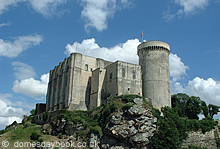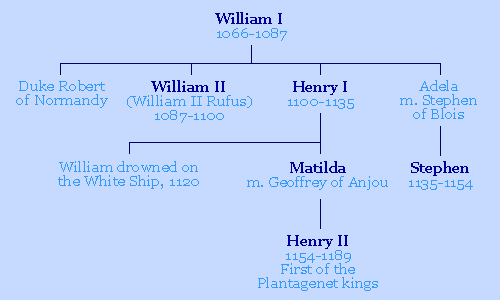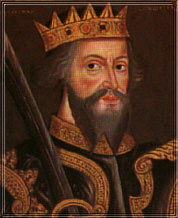|
|
 |
William the Conqueror
Early Years
1028
1035
1036
1037
1042
1043
1045
1046
1047
1049
1050
|
(Autumn?) - Born in Falaise, Normandy, an illegitimate son
Duke Robert I (William's father) dies in Bithynia; accession of William as Duke William II of Normandy, aged 7
Murder of Edward the Confessor's brother, Alfred
Archbishop Robert I of Rouen, France, dies; succeeded by William's uncle, Mauger
Accession of Edward the Confessor as King of England
Coronation of Edward
Marriage of Edward to Edith, daughter of Earl Godwine of Essex. Magnus of Norway threatens to invade England
Revolt of the western vicomtes and Guy of Burgundy in Normandy. William defended by King Henry
William present at proclamation of the Truce of God in Normandy at church council in Caen
William recaptures Brionne
William re-enters Rouen
| Back to top

Battle for France
1051
1051-52
1051/52
1052
1053
1053
1056
1057
1058
1058
1060
1063
1064
1064
1066
|
About the time of a rebellion by Earl Godwine against Edward the Confessor, William is promised succession to the English throne
Warfare between William and Geoffrey, Count of Anjou, round Domfront and Alençon
William marries Matilda, daughter of Count Baldwin V of Flanders
Expulsion of many Normans from England, Earl Godwine and sons are returned land lost due to rebellion
Earl Godwine dies
Capture of Arques by William
Robert, William's half-brother, becomes Count of Mortain
King Henry and Count Geoffrey of Anjou join forces and invade Normandy
Siege of Thimert by King Henry after capture by William
Son of Harold Hardraada, Magnus, attacks England
King Henry I of France dies; succeeded by Philip I
Conquest of Maine by William
Harold Godwineson visits Normandy
William invades Brittany
(5th January) Edward the Confessor dies
(Spring) Norman mission to Rome to seek papal support
(6th June) Coronation of Harold Godwineson
| Back to top

The English Conquest
|
1066
|
(September) William's fleet assembles in the Dives
(8th September) Harold Godwineson disbands army in southern England
(September) Harold Hardraada, King of Norway, invades northern England
(20th September) Battle of Fulford
(25th September) Battle of Stamford Bridge
(28th September) William lands at Pevensey
(29th September) William occupies Hastings
(6th October) Harold Godwineson in London
(14th October) Battle of Hastings
(21st October) Submission of Dover
(29th October) Submission of Canterbury
(Early December) William marches round London
(25th December) Coronation of William as King of England
| Back to top

The post-Conquest years
1067
1068
1069
1070
1071
1073
1075
1076
1077
1079
1080
1081
1082
1083
1085
1086
1087
|
(March-Dec) William in Normandy
(Autumn) Odo, Bishop of Bayeux, becomes Earl of Kent
(Summer) William enters York
(Feb-Apr) York rebels but is retaken by William
(Summer) Invasion of Yorkshire by Swein Estrithson, King of Denmark; general uprising of the north supported by Malcolm III, King of Scotland
(20th Sept) Rebels occupy York
William retakes York
(Jan-Mar) William's campaign in Teesdale; marches over Pennines; occupation of Stafford and Chester
(15th Aug) Lanfranc becomes Archbishop of Canterbury
(Summer) King Malcolm ravages northern England
(Summer) Departure of Danish from English coast
Capture of Bari and Palermo by Normans
(Autumn) William invades Scotland; pact of Abernethy
William invades and reconquers Maine
English earls revolt
(Sept-Nov) Campaign in Brittany. William defeated at Dol
Pact between William and King Philip
1st revolt of Robert, William's eldest son, against his father
William defeated at Gerberoi
(Aug-Sept) Devastation of northern England by King Malcolm of Scotland
Robert is reconciled to his father
Robert invades Scotland; foundation of 'New Castle'
William loses La Flèche to Fulk le Rechin
Pact between William and Fulk
Odo, Bishop of Bayeux, imprisoned
New revolt of Robert against his father
(2nd Nov) Death of William's wife, Matilda
(25th May) Cnut IV of Denmark prepares to invade England
(Dec) William holds Christmas Court at Gloucester, where the Domesday Book is planned
(July) Murder of Cnut IV
William crosses to Normandy
(9th Sept) William the Conqueror dies early in the morning at Saint-Gervais near Rouen
| Back to top

William's parents
 |
| The keep of Falaise Castle, in William's home town in Normandy |
William's father was Robert I, sixth Duke of Normandy. He was no older than 21 at the time of William's birth, and came from a family with a rich heritage. He was a direct descendant of Rollo the Viking, ruler of Neustria, who landed in Normandy and claimed the land after being ejected from Norway by the king. Rollo's power was inherited first by William, nicknamed 'Longsword' (d.942), then Duke Richard I (942-966), then by William the Conqueror's grandfather, Duke Richard II. When William was born in 1027/28, Robert was Count of Hiesmois; he acceded to the title Duke of Normandy in 1028. In 1034 he left for a pilgrimage to Jerusalem and died before his return in late 1035, leaving William as his successor at just 7 years old. Despite being so young and a bastard son, William was accepted by Norman nobles, though several attempts were made to despose him of his position, including while he was ruling England. It was for this reason that during his reign as King, William spent as much time in Normandy enforcing his power as he did overseeing affairs in England.
His mother Herleva, daughter of Fulbert the tanner, came from Falaise and rose to a prominent status in French nobility despite her ordinary upbringing. At the age of 16 she met Gilbert, Count of Brionne, and had a son, Richard fitzGilbert (fitz denoting his illegitimacy). Just a couple of years later, with Robert, Duke of Normandy, she gave birth to William in 1027/28 and a daughter, Adelaide. Shortly before Robert's death in 1035 she was persuaded by him to marry Herlwin, Viscount of Conteville. By him she bore a daughter, Muriel and 2 sons, Odo - who would become Bishop of Bayeux - and Robert - who would become Count of Mortain. Both men, along with fitzGilbert, would play major parts in assisting William's conquest of England.
Back to top

Norman family tree

Back to top

© 1999-2024 domesdaybook.co.uk. All rights reserved
Privacy Policy | Cookie Settings

|
 |




